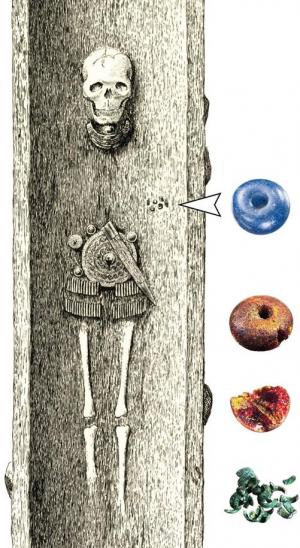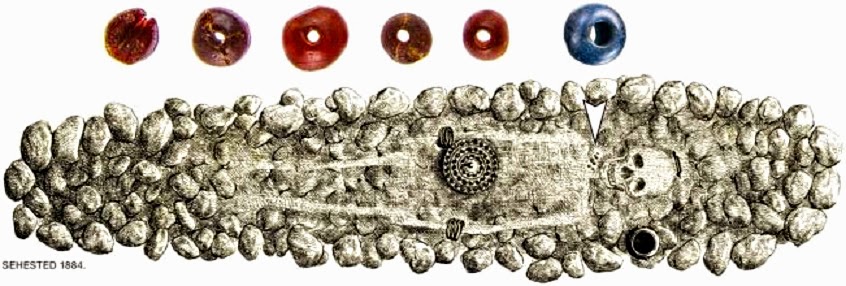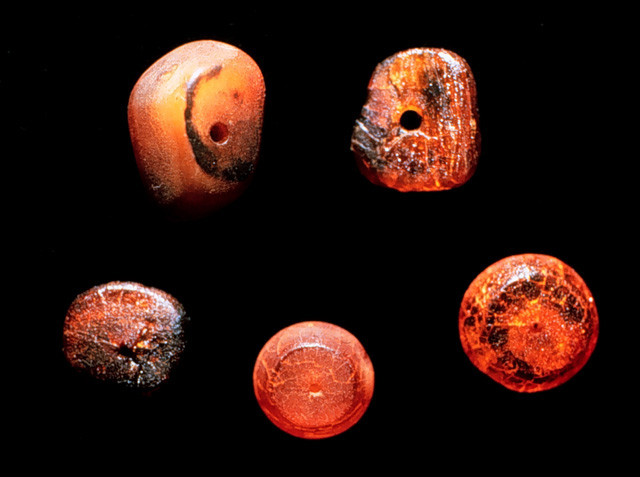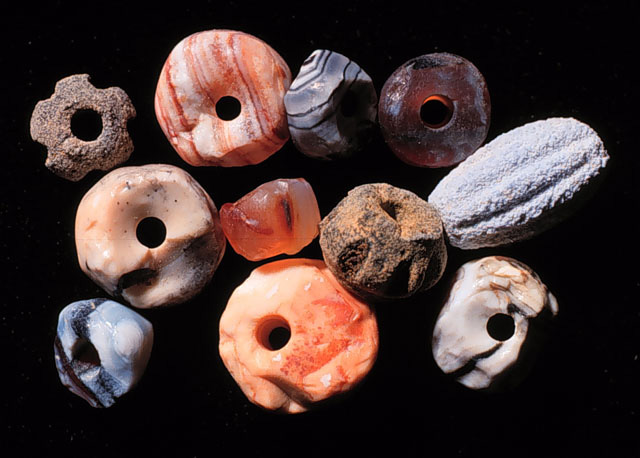It looks like you're using an Ad Blocker.
Please white-list or disable AboveTopSecret.com in your ad-blocking tool.
Thank you.
Some features of ATS will be disabled while you continue to use an ad-blocker.
30
share:
Full title: Analyses of glass beads found in Denmark give us new knowledge of Bronze Age trade routes.
Glass beads in Denmark

The glass bead turned out to be Egyptian. This is the first time that typical Egyptian cobalt glass has been discovered outside the Mediterranean area.It has been known for a long time that amber was exported in the Bronze Age from Nordic latitudes and southwards. Tutankhamun and other Egyptian pharaohs had large amber chains in boxes in their burial chambers.
In 1864 a grave was found that also had beads in it that are now known to have come from Egypt also.

Glass beads in Denmark

Archeologists Jeanette Varberg from Moesgaard Museum and Flemming Kaul from the National Museum, and Bernard Gratuze, director of IRAMAT, analysed the composition of some blue glass beads found on buried Bronze Age women in Denmark. The analyses revealed that the glass originate from the same glass workshops in Egypt that supplied the glass that the Egyptian Pharaoh Tutankhamun took with him to his grave in 1323 BC.
The glass bead turned out to be Egyptian. This is the first time that typical Egyptian cobalt glass has been discovered outside the Mediterranean area.It has been known for a long time that amber was exported in the Bronze Age from Nordic latitudes and southwards. Tutankhamun and other Egyptian pharaohs had large amber chains in boxes in their burial chambers.
In 1864 a grave was found that also had beads in it that are now known to have come from Egypt also.

Not to go off on a tangent or anything, but I always think about the first explorers/traders that established these routes of such great distance.
I'm sure that they are all links in a chain that kept growing outward from the source (A trades with B, then C finds B and begins trading, which
opens up direct trade with A, then D finds C and begins trade, and so on...), but to be those people would have been exhilarating and frightful all at
the same time.
I would assume it being akin to Lewis and Clarke and the like, but still amazing that people are willing to risk their lives like that, and often for material things that do nothing to aid in survival, or just for the pursuit of the knowledge of what's over the next ridgeline.
Or to hide the Ark of the Covenant on Oak Island...you know, whatever
I would assume it being akin to Lewis and Clarke and the like, but still amazing that people are willing to risk their lives like that, and often for material things that do nothing to aid in survival, or just for the pursuit of the knowledge of what's over the next ridgeline.
Or to hide the Ark of the Covenant on Oak Island...you know, whatever
I have read about the glass beads long ago around that time frame in the Egypt area. I also have read evidence of the trade routes to Europe possibly
being there. This is pretty good evidence to prove the existence of these routes. They knew this was happening but had no real evidence to back it.
I get tired of the saying there is no evidence when they have some written evidence that something was going on, calling it mythology because of lack
of evidence.
Would this be in the time of the original Odin or Woden? If so, I feel that this can show that gunpowder knowledge in the writings may also have existed in Northern Europe from trade associations. Thors Hammer. This would have came from the Chinese knowledge of gunpowder dating back to I think around 2000 BC
Would this be in the time of the original Odin or Woden? If so, I feel that this can show that gunpowder knowledge in the writings may also have existed in Northern Europe from trade associations. Thors Hammer. This would have came from the Chinese knowledge of gunpowder dating back to I think around 2000 BC
I know of a group of people from the Israelite tribe of Dan that fled a war circa 1300 BCE between Israel and Assyria during the time of Judges, as
recorded in Judges.
They were recently set free from Egyptian captivity about 150 years years prior during the events recorded in Exodus, they still would have had many aspects of Egyptian culture.
Dan left the "mark" of their tribe everywhere they traveled as they fled via the Mediterranean Sea Westward. Archaeological findings indicate the final destination of these fleeing Danites was the land called Denmark (Dan's Mark), this discovery can be added to those other findings.
Truly former Egyptians (Israelite slaves) traveled/fled that region of the world and landed in the modern day Nation of Denmark circa 1300 BCE. A time frame which fits particularly well with the findings in this discovery.
God Bless,
They were recently set free from Egyptian captivity about 150 years years prior during the events recorded in Exodus, they still would have had many aspects of Egyptian culture.
Dan left the "mark" of their tribe everywhere they traveled as they fled via the Mediterranean Sea Westward. Archaeological findings indicate the final destination of these fleeing Danites was the land called Denmark (Dan's Mark), this discovery can be added to those other findings.
Truly former Egyptians (Israelite slaves) traveled/fled that region of the world and landed in the modern day Nation of Denmark circa 1300 BCE. A time frame which fits particularly well with the findings in this discovery.
God Bless,
originally posted by: rickymouse
I have read about the glass beads long ago around that time frame in the Egypt area. I also have read evidence of the trade routes to Europe possibly being there. This is pretty good evidence to prove the existence of these routes. They knew this was happening but had no real evidence to back it. I get tired of the saying there is no evidence when they have some written evidence that something was going on, calling it mythology because of lack of evidence.
Would this be in the time of the original Odin or Woden? If so, I feel that this can show that gunpowder knowledge in the writings may also have existed in Northern Europe from trade associations. Thors Hammer. This would have came from the Chinese knowledge of gunpowder dating back to I think around 2000 BC
The original Woden/Odin (Danus I) came to power after the power vacuum occurred at the death of the ancient Germanic Emperor Wolfheim. His empire was divided among his three sons Kells, Gall and Hiller.
When the Empire was split the land of Denmark and all of Scandinavia was left without a ruler. The Danites living in Denmark at the time called on a scion from the house of Judah to rule over them (as David, from the house of Judah was king in Israel at the time of the Germanic empirical breakup).
Dan I (called Danus I by Roman historians) answered the call and became the first ancient king of the Danes.
Odin/Woten traveled the world, and even had been recorded as visiting King David in Jerusalem during their contemporary reigns.
Both David and Odin ruled circa 1050 BCE, however the tribe of Dan was in Denmark since 1300 BCE, which is why the Egyptian beads were there then.
God Bless,
a reply to: ElohimJD
This is a much better explanation of the line of Dan than I read in my studies. It sounds about right too. I read about four articles on this and what you said compiles a lot of what I read on these different articles. You must have studied this more than I did. I got hooked on it after reading something in the Ruins translations.
Funny about the word Ruins/Runes, I have seen it spelled about three ways. Does anyone actually know the proper spelling or it one of those things that is spelled differently depending on the culture?
This is a much better explanation of the line of Dan than I read in my studies. It sounds about right too. I read about four articles on this and what you said compiles a lot of what I read on these different articles. You must have studied this more than I did. I got hooked on it after reading something in the Ruins translations.
Funny about the word Ruins/Runes, I have seen it spelled about three ways. Does anyone actually know the proper spelling or it one of those things that is spelled differently depending on the culture?
nice post hans,
the beads were part of the med. trade chain for sure, carried to scandanavia by myceneans, and before them by the minoans, both of whom had trade colonies in eygypt.
The scandanavian elite at this time adopt almost the entire mycenean warrior cultural package, including clean shaven faces and daggers as sign of status. The scandanavian stone ships have been shown to mark market places were the mediteranian trades would put in on the river bank.
fascinating stuff
the beads were part of the med. trade chain for sure, carried to scandanavia by myceneans, and before them by the minoans, both of whom had trade colonies in eygypt.
The scandanavian elite at this time adopt almost the entire mycenean warrior cultural package, including clean shaven faces and daggers as sign of status. The scandanavian stone ships have been shown to mark market places were the mediteranian trades would put in on the river bank.
fascinating stuff
a reply to: rickymouse
I would bet Thor's Hammer actually did exist as some kind of weapon. I find it interesting the trading across the world no matter how far you go back, it looks as though the wealthy were getting items to make themselves above and stand out. Much of what is found is non practical items and probably out of the reach of the average guy.
If so, I feel that this can show that gunpowder knowledge in the writings may also have existed in Northern Europe from trade associations. Thors Hammer. This would have came from the Chinese knowledge of gunpowder dating back to I think around 2000 BC
I would bet Thor's Hammer actually did exist as some kind of weapon. I find it interesting the trading across the world no matter how far you go back, it looks as though the wealthy were getting items to make themselves above and stand out. Much of what is found is non practical items and probably out of the reach of the average guy.
Thanks for all the replies!
A few comments
ElohimJD: what is source document for that legend?
Multiple: Gunpowder, that is a not uncommon thought to try and explain godly powers as the use of gunpowder. black powder is seemingly an easy formula, charcoal, sulfur and salt petre, yet it took centuries to perfect. I recently researched how gun powder was made in the 1830's as I was reading the journal of a man who actually set up a manufacturing site in central Asia to make gunpowder (using the French method) it was very complicated; going down to the type of wood used, when it was harvested, how it was dried and how it was made into charcoal, getting proper sulfur was a complex task too, and refining SP even more complex. In other words making good gunpowder was an industrial process learned over centuries of trial and error. Just mixing those three ingredients at 75%, 12.5% and 12.5% gives you just a puff.
A few comments
ElohimJD: what is source document for that legend?
Multiple: Gunpowder, that is a not uncommon thought to try and explain godly powers as the use of gunpowder. black powder is seemingly an easy formula, charcoal, sulfur and salt petre, yet it took centuries to perfect. I recently researched how gun powder was made in the 1830's as I was reading the journal of a man who actually set up a manufacturing site in central Asia to make gunpowder (using the French method) it was very complicated; going down to the type of wood used, when it was harvested, how it was dried and how it was made into charcoal, getting proper sulfur was a complex task too, and refining SP even more complex. In other words making good gunpowder was an industrial process learned over centuries of trial and error. Just mixing those three ingredients at 75%, 12.5% and 12.5% gives you just a puff.
a reply to: Hanslune
Hiya Hans and all the best for Christmas
Those old trade routes were so extensive. Remarkable that commerce managed to transcend the language barriers, mini-fiefdoms and challenges of passing through thousands of miles of 'lawless' wilds.
The Egyptian beads remind me of the jadeite hand axe that was quarried in Italy and landed up in the British Isles around 6000ya. On the surface, a European hand axe doesn't have much in common with the beads from Egypt. However, it's the way they were transported from one point to another that captures my imagination.
Modern Europe has so many distinct languages whereas ancient Europe would have shared a small number of languages and dialects that overlapped into Lingua Francas. The trade routes would have benefited from the ease with which communities, hundreds of miles apart, could communicate on basic levels.
Hiya Hans and all the best for Christmas
Those old trade routes were so extensive. Remarkable that commerce managed to transcend the language barriers, mini-fiefdoms and challenges of passing through thousands of miles of 'lawless' wilds.
The Egyptian beads remind me of the jadeite hand axe that was quarried in Italy and landed up in the British Isles around 6000ya. On the surface, a European hand axe doesn't have much in common with the beads from Egypt. However, it's the way they were transported from one point to another that captures my imagination.
Modern Europe has so many distinct languages whereas ancient Europe would have shared a small number of languages and dialects that overlapped into Lingua Francas. The trade routes would have benefited from the ease with which communities, hundreds of miles apart, could communicate on basic levels.
originally posted by: Hanslune
Thanks for all the replies!
A few comments
ElohimJD: what is source document for that legend?
Multiple: Gunpowder, that is a not uncommon thought to try and explain godly powers as the use of gunpowder. black powder is seemingly an easy formula, charcoal, sulfur and salt petre, yet it took centuries to perfect. I recently researched how gun powder was made in the 1830's as I was reading the journal of a man who actually set up a manufacturing site in central Asia to make gunpowder (using the French method) it was very complicated; going down to the type of wood used, when it was harvested, how it was dried and how it was made into charcoal, getting proper sulfur was a complex task too, and refining SP even more complex. In other words making good gunpowder was an industrial process learned over centuries of trial and error. Just mixing those three ingredients at 75%, 12.5% and 12.5% gives you just a puff.
Not to mention that the accepted date for the first gunpowder (China) is definitely in the Common Era, as it's earliest mention in any text we have is around 150 CE and Chinese writing goes back to at least 2500 BC (though we don't have much in the way of samples that are as old as that.)
Harte
They found the same in Ireland, the Tara prince wearing faience beads identical to the ones on Egyptian pharaohs.
Also there is the grave of queen Scota
Also there is the grave of queen Scota
a reply to: rowanflame
Thanks
------------------------------------------------------
Additionally an amphora of similar beads was found in the wreckage of the Uluburun ship

Baltic amber beads found of the south Turkish coast

Egyptian and Mycenaean beads
Link to bead images
Ship wreck
Wikipedia summary of the ship wreck
Thanks
------------------------------------------------------
Additionally an amphora of similar beads was found in the wreckage of the Uluburun ship

Baltic amber beads found of the south Turkish coast

Egyptian and Mycenaean beads
Link to bead images
Ship wreck
Wikipedia summary of the ship wreck
new topics
-
A Warning to America: 25 Ways the US is Being Destroyed
New World Order: 1 hours ago -
President BIDEN's FBI Raided Donald Trump's Florida Home for OBAMA-NORTH KOREA Documents.
Political Conspiracies: 7 hours ago -
Maestro Benedetto
Literature: 8 hours ago -
Is AI Better Than the Hollywood Elite?
Movies: 9 hours ago
top topics
-
President BIDEN's FBI Raided Donald Trump's Florida Home for OBAMA-NORTH KOREA Documents.
Political Conspiracies: 7 hours ago, 27 flags -
Weinstein's conviction overturned
Mainstream News: 17 hours ago, 8 flags -
Gaza Terrorists Attack US Humanitarian Pier During Construction
Middle East Issues: 13 hours ago, 8 flags -
Massachusetts Drag Queen Leads Young Kids in Free Palestine Chant
Social Issues and Civil Unrest: 15 hours ago, 7 flags -
Las Vegas UFO Spotting Teen Traumatized by Demon Creature in Backyard
Aliens and UFOs: 12 hours ago, 6 flags -
Meadows, Giuliani Among 11 Indicted in Arizona in Latest 2020 Election Subversion Case
Mainstream News: 15 hours ago, 5 flags -
2024 Pigeon Forge Rod Run - On the Strip (Video made for you)
Automotive Discussion: 13 hours ago, 4 flags -
Is AI Better Than the Hollywood Elite?
Movies: 9 hours ago, 3 flags -
A Warning to America: 25 Ways the US is Being Destroyed
New World Order: 1 hours ago, 3 flags -
Maestro Benedetto
Literature: 8 hours ago, 1 flags
active topics
-
New whistleblower Jason Sands speaks on Twitter Spaces last night.
Aliens and UFOs • 65 • : Jukiodone -
HORRIBLE !! Russian Soldier Drinking Own Urine To Survive In Battle
World War Three • 50 • : F2d5thCavv2 -
Russia Ukraine Update Thread - part 3
World War Three • 5732 • : F2d5thCavv2 -
The Acronym Game .. Pt.3
General Chit Chat • 7751 • : F2d5thCavv2 -
Salvador Dali's Moustaches
People • 28 • : zosimov -
Is AI Better Than the Hollywood Elite?
Movies • 17 • : ThePsycheaux -
The best Rice dish i've ever tasted... Kimchi Rice
Food and Cooking • 26 • : lamhaocc -
A Warning to America: 25 Ways the US is Being Destroyed
New World Order • 1 • : 727Sky -
Massachusetts Drag Queen Leads Young Kids in Free Palestine Chant
Social Issues and Civil Unrest • 15 • : tarantulabite1 -
How ageing is" immune deficiency"
Medical Issues & Conspiracies • 35 • : annonentity
30
